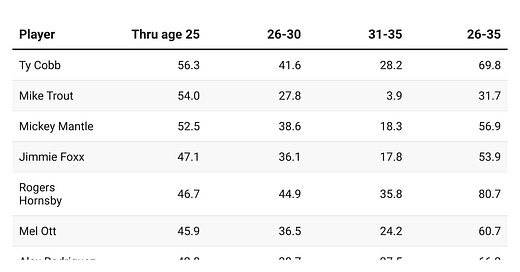Juan Soto finished third in the AL MVP vote, behind teammate Aaron Judge and Bobby Witt Jr. And it’s hard to say that he should have placed above either of those two players. Yet timing is everything. Soto is a free agent now while Judge recently re-signed and Witt is several years away. And because he’ll enter next year in his age-26 season, Soto is going to get a massive contract from someone.
The twin pillars of youth and talent make coming up with the years/total value of his upcoming deal next to impossible to predict. It does seem fair to think he won’t defer money to the extent that Shohei Ohtani did. After that – who knows?
Facebook friend John Coppinger recently offered his guess.
$700M, 15 years.
$47 million per over the first five seasons. $235M for his age 26-30 seasons. Then give him an opt out. If he takes it, you're out from the other $565M and you got his prime uphill seasons. But give him an incentive to stay. Here's that incentive:
$60 million per over the next five seasons. $300M for his age 31-35 seasons. Then give him another opt out. If he thinks he can get more than $165 million for his age 36-40 seasons, God speed to him. You got (all) of his prime seasons.
And if he doesn't take it and you're stuck, then at least $33 million a year for the final five seasons will be nothing by the time the year 2034 comes along. I maintain that the opt outs would wind up being mutually beneficial. And just think: when Soto is 36, the Mets will finally be out from under the Bonilla contract!
This is as reasonable a guess as one could make. But it did make me think that the deal could be tweaked and likely offer the Mets a chance to get Soto on a 5-year deal, instead. It’s going to take a deal with double-digit years to land Soto. But, in an ideal world, a club wouldn’t tie itself to one player for that long. There’s just too much that could potentially go wrong.
With that thought in mind, my proposal is the same length and the same total dollar values as what Coppinger proposed. The tweak is to give him $60 million for the first five years and then $47 million for the next five.
Most people would shoot down this proposal, saying he would definitely opt out after the first five years. Yeah, he probably would. But when is he most likely to put up the most value? My opinion is in the first five years. When is he most likely to either begin his decline or get injured? My opinion is in the second five years.
My belief is that this proposal would be very enticing to Soto. He gets the security of the 15-year deal, in case injuries or decline set in early. He gets the highest-ever AAV in the first five years of the deal. And if everything goes great, he can hit free agency again in time for his age-31 season, when chances are he can get a deal with a greater AAV than the $47 million he’s leaving on the table.
As for the Mets – How great would it be to have Soto for five years covering all of his prime? Sure, the greedy out there will want Soto for longer than that. But is this a “careful what you wish for” scenario? Soto is one of the top young players in MLB history. Here’s how all of the people in MLB above him in fWAR thru their age-25 seasons did in the next five-year intervals:
Of the 15 players above him in production, only three were able to post a 30.0 fWAR or greater in their age-31-35 seasons. Twice as many failed to reach 20 fWAR, although a couple of those come with caveats. Trout has only had two seasons in the 31-35 span and Vaughan missed time due to World War II. Should we be gashed by not receiving roughly 25 fWAR for $235 million, which is the amount the Mets would pay Soto for his age-31-35 seasons, as they would in my proposal?
The way free agency works for most stars is that they get a longer deal than they should. They get paid more on the back end than what they’re worth, to make up for not getting paid as much in the beginning as they should. It works out for the clubs because they’ll get a lower AAV for Luxury Tax purposes. But this proposed deal of mine still results in a lower AAV yet gives the player the money, essentially, up front.
It’s a win-win situation. And for the clubs there’s an extra win, as it minimizes risk in the back half – or in this case, the back two-thirds – of the contract. There’s less risk for the Mets to be struck paying $33 million and up for a guy either injured or past his prime.
Thanks for reading Mets360! Subscribe for free to receive new posts and support my work.





What makes the most sense, is that paying him more in the first five years makes it easier for him to opt out and maybe get a better contract for the last five years. But I would be shocked if these players opted out given that they don’t really need any more money. Still shocked that Blake Snell opted out of a $31 million contract thinking someone would pay him more. Garrett Cole came to his senses by realizing that no one was gonna give him the same value contract other than the Yankees. And the Yankees basically dared him to go. Anyone going longer than a 10 year deal on a 25/26 year-old player is just setting them up for disappointment at the end. It will be very interesting in three or four years if Shohei Otani starts to decline, but it seems that the Dodgers have picked up so much additional revenue from him being on their team that the dollars are starting to feel irrelevant, or at worst, not so devastating. Seems that MLB teams are no longer whining about the money they are losing because they must be making a fortune to be able to afford such huge contracts. And whoever came up with the qualifying offer dollar amount is also a bit delusional. So the Mets pay Severino 13 or $14 million and the only way they can protect themselves and get a draft pick is by giving him a six or $7 million raise. There is simply something about the economics of this game that have changed in addition to the TV contracts. All that being said, if Steve Cohen wants to pay Juan Soto to be on the Mets, and Soto takes the deal, we will all be thrilled. It’s other people‘s money and we live in a great country.
Brian, this was very educational. But, one thing that I learned is that almost all these players had more WAR in their first five years than in their “prime” years. Maybe there brakes need to be pumped on Soto? I agree with you on the front loading and wonder what Coppinger was thinking when he wrote it. He is a good player and can help any roster. I have never heard of him being any type of leader however, so what does it say when Batman is making $34MM per year and Robin is making $50+?